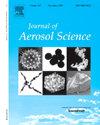Parabolic flow tube reactor for tandem DMA studies of cluster ion evaporation kinetics: Design, theoretical data inversion, and preliminary results for ionic liquid nanodrops
IF 2.9
3区 环境科学与生态学
Q2 ENGINEERING, CHEMICAL
引用次数: 0
Abstract
We seek to infer single-molecule evaporation rates from airborne ionic liquid clusters mobility-selected on a first DMA, flowing through a heated tube, with the ratio of product to parent fluxes determined on a second DMA. We connect theoretically the measured flux ratio to the reaction rate k via separation of variables, by assuming parabolic flow at large Peclet number (Pe). To minimize the non-parabolic entry flow region, we operate at moderate Reynolds numbers (∼150), resulting in a limited Pe. We identify practical conditions with small entry length and negligible finite-Pe corrections for the full (elliptic) non-reactive problem, which is numerically manageable despite the non-orthogonal eigenfunctions. We argue that moderate Pe corrections for the reactive problem are also small. The parent species problem is analogous to the nonreactive Graetz problem, though including the dimensionless first order reaction rate K as a free parameter. The product species problem involves an extra diffusivity ratio γ and non-standard functions, efficiently calculated by the computer program Mathematica. All other calculations involve diagonal matrices, enabling covering all the relevant range of dimensionless parameters: 1≤K ≤ 100; 1≤γ ≤ 1.4; arbitrary tube length x. These numerical results are condensed into tables for interpolations, enabling the quick inference of reaction constants from experimental data. The procedure is used to invert experimental data yielding the volatility of clusters of the ionic liquid EMI-FAP having diameters smaller than 3 nm. The approach is limited to situations where only one or two reaction products form.
聚簇离子蒸发动力学的抛物流管反应器研究:设计、理论数据反演和离子液体纳米滴的初步结果
我们试图从空气中离子液体团簇的迁移率推断出单分子蒸发速率——在第一个DMA上选择,流经加热管,在第二个DMA上确定产品与母体通量的比例。我们通过分离变量,假设大佩莱特数(Pe)的抛物流,从理论上将测量的通量比与反应速率k联系起来。为了最小化非抛物线入口流区,我们在中等雷诺数(~ 150)下操作,导致有限的Pe。我们确定了具有小入口长度和可忽略的有限pe修正的全(椭圆)非反应问题的实际条件,尽管具有非正交特征函数,但在数值上是可管理的。我们认为反应性问题的中等Pe修正也很小。母种问题类似于无反应的Graetz问题,但包含了无量纲的一阶反应速率K作为自由参数。积种问题涉及一个额外的扩散比γ和非标准函数,由计算机程序Mathematica有效地计算。其他计算均采用对角矩阵,可覆盖所有相关的无量纲参数范围:1≤K≤100;1≤γ≤1.4;这些数值结果被浓缩到表格中,以便插值,从而可以从实验数据中快速推断出反应常数。该程序用于反演实验数据,得到直径小于3nm的离子液体EMI-FAP簇的挥发性。这种方法仅限于只有一种或两种反应产物形成的情况。
本文章由计算机程序翻译,如有差异,请以英文原文为准。
求助全文
约1分钟内获得全文
求助全文
来源期刊

Journal of Aerosol Science
环境科学-工程:化工
CiteScore
8.80
自引率
8.90%
发文量
127
审稿时长
35 days
期刊介绍:
Founded in 1970, the Journal of Aerosol Science considers itself the prime vehicle for the publication of original work as well as reviews related to fundamental and applied aerosol research, as well as aerosol instrumentation. Its content is directed at scientists working in engineering disciplines, as well as physics, chemistry, and environmental sciences.
The editors welcome submissions of papers describing recent experimental, numerical, and theoretical research related to the following topics:
1. Fundamental Aerosol Science.
2. Applied Aerosol Science.
3. Instrumentation & Measurement Methods.
 求助内容:
求助内容: 应助结果提醒方式:
应助结果提醒方式:


